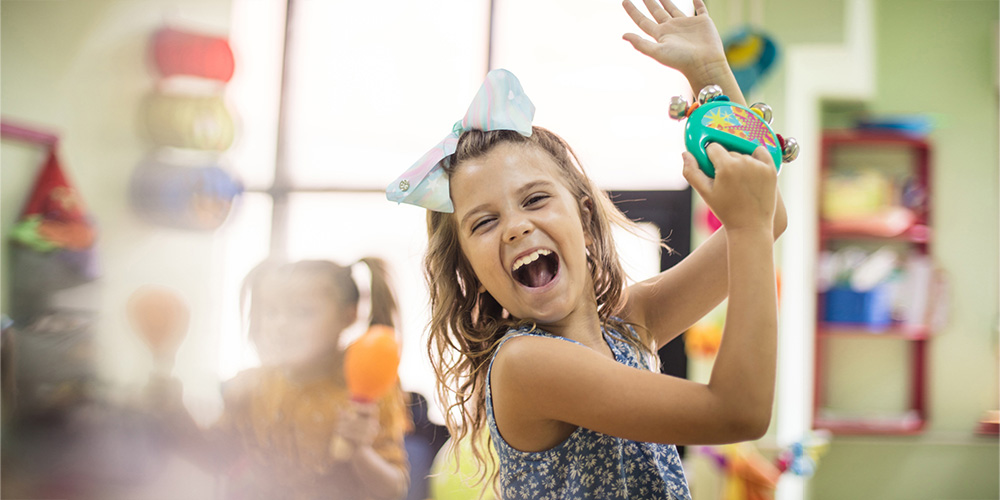Do you ever think about what learning looks like on a neurological level? Ever imagined how the lessons you’ve prepared might be activating neurons in different parts of your students’ brains? How what they’re thinking about may literally be forging new connections and pathways on a biological level?
Of all the teaching tools you can use in the classroom, music is one that is guaranteed to exercise multiple parts of the brain at the same time. Research(Open Link in new tab) has shown that music engages not only vital intellectual processes, but also emotional centers in the brain, making it a perfect learning aid in any classroom. No matter what subject or grade you teach, your students will benefit from having music as part of their lessons. Let’s see how.
How Music Influences the Mind
So how does music impact the brain? Turns out, almost every way you can think of! Whether they’re passively listening, moving to the rhythm, or creating their own music, students’ brains simply can’t help but light up when they engage with this artform. Here’s how the different parts(Open Link in new tab) of the brain(Open Link in new tab) react when you flip the radio on:
- Frontal lobe: Music enhances thinking, decision making, and planning.
- Temporal lobe: Music is, of course, auditory. The temporal lobe produces our ability to hear and make noise. One hemisphere produces language and words and the other produces sounds.
- Broca’s area: Playing music helps us become better communicators. For example, learning signs and tones can translate into conveying verbal information.
- Wernicke’s area: This part of the brain comprehends words, both written and spoken. We exercise this area when listening to music.
- Occipital lobe: This lobe enables sight. Some students visualize music (through storytelling lyrics or the imagery the sounds inspire).
- Cerebellum: This allows movement and stores memory. Whether a student is dancing in gym class or remembering when they heard a song for the first time, music exercises this part of the brain.
- Nucleus accumbens: This area produces dopamine. This chemical releases when we listen to music.
- Amygdala: This area triggers emotions. No doubt music makes us feel things, changes our mood, etc.
- Hippocampus: Music increases neurogenesis in the hippocampus, which improves memory retention.
- Hypothalamus: Music is known to positively affect blood pressure and heart rate, which are regulated by the hypothalamus.
- Corpus callosum: This part enables both coordination and logic. When reacting to music through dance or drawing or discussion, students use the corpus callosum.
- Putamen: This part processes rhythm and regulates movement. If used in gym class, music exercises the putamen.
Classroom Activities: Learning Through Music
Even if you’re not a music teacher, there are many opportunities to integrate dance, music appreciation, and music history into your curriculum.
History and Storytelling Lessons
Many songs detail historic events and can be a great tool for helping students remember key facts. Plus, you can discuss the musician’s historical interpretation of the subject, and talk about how art can help listeners explore and speculate about details the history books leave out. Here are some examples of songs you might play for your class:
- “Brothers” by Randy Newman(Open Link in new tab): U.S. presidents have had to make some incredibly weighty decisions over the years. Ever wonder what their conversations and thought processes were like? This song speculates what President John F. Kennedy might have talked about with his younger brother Bobby as he wrestled with how to respond to Castro’s takeover of Cuba in 1961.
- “Pocahontas” by Neil Young(Open Link in new tab): Early U.S. history is rife with heartbreaking abuses and clashes between early American settlers and Native Americans. This song, only appropriate for more mature students, describes an unspecified massacre of Native Americans.
- “The Visitors” by ABBA(Open Link in new tab): In the 1970s and early 80s, Soviet backlash against their political rivals was crippling—involving everything from exile to punitive psychiatry to imprisonment and labor camps. Pop group ABBA wrote this song to speak out against the mistreatment of these political dissenters.
- “Battle of New Orleans” by Johnny Horton(Open Link in new tab): Written by a high school history teacher specifically to help students’ learning, this song details the famous Battle of New Orleans, led by Andrew Jackson at the end of the War of 1812.
Music Appreciation Lessons
Grades K–6: Imagining with Music(Open Link in new tab)
Sammy Sprinkles uses movie soundtracks to show students how music can inform and enhance emotions. She challenges kids to close their eyes and imagine a scene that fits the “mood” of the music, and then draw a picture of what they imagined. To bring this activity to your classroom, you can use the songs she picked or choose a couple of tracks of your own.
Grades 9–12: Music Appreciation Can Increase Empathy(Open Link in new tab)
In this TEDx Talk, musician and writer Diane Miller talks about how music can not only spark passion in our own souls, but also help us encounter the deepest thoughts and feelings of others, making us more open and empathetic people. To bring this idea home, ask your students to find a song that speaks to them written by someone or about something very different from their own experience, and share how the song increases their understanding of the world.
P.E. Activities
Move and Freeze(Open Link in new tab)
Great as a brain break or warmup activity, this song guides students through some simple exercises, with the added fun of telling them to freeze unexpectedly every few seconds.
Dance Monkey(Open Link in new tab)
Combine dance and exercise with this rigorous warmup routine inspired by the movements of monkeys.
Jump Up, Bend Down(Open Link in new tab)
Your students won’t even realize they’re working just about every muscle in their bodies as they follow along with this fun dance routine.







